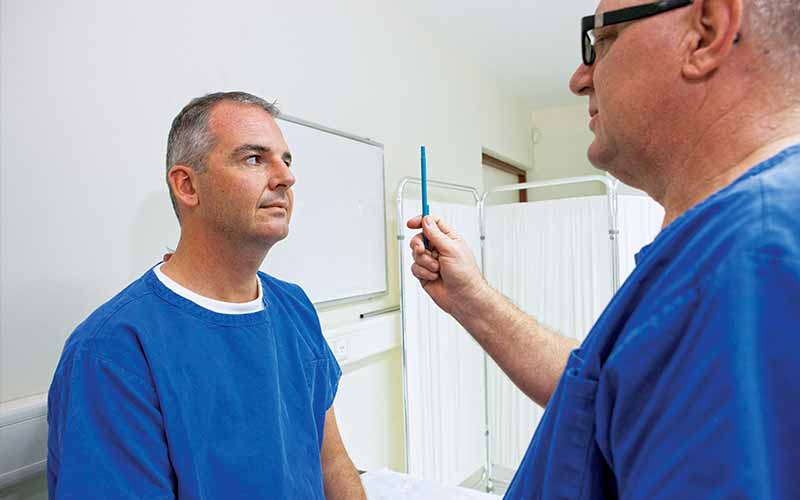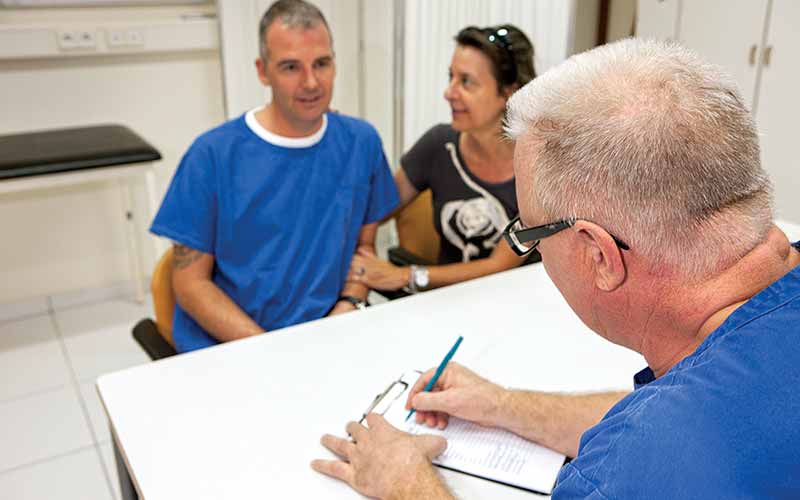Whether you’re exploring Australia’s coral reefs, drifting through warm Caribbean waters or diving into a crisp Canadian lake, nothing puts a damper on a dive vacation quite like a trip to the emergency room (ER). Anxiety and uncertainty accompany most illnesses and injuries — from cuts that need stitches to more serious problems like chest pain. Unfortunately, even the most well-planned dives by careful and experienced divers may result in ER visits. A little knowledge, whether about ear squeezes or decompression sickness (DCS), can go a long way in reducing anxiety around trips to the ER.
DAN’s medical staff is available to offer advice about dive injuries and provide recommendations about the need for medical care. In complex and more serious cases DAN can work with local facilities to help coordinate care or arrange emergency medical evacuations. If you experience symptoms after diving, activate local emergency medical services or safely get yourself to the nearest ER. Call the DAN Emergency Hotline at +1-919-684-9111 if you wish to discuss your symptoms with an expert in dive medicine.
One of the most common problems in the management of dive accidents is delay in seeking care. If you are worried you may be suffering from a diving-related medical problem, don’t hesitate to make the call. Whether a DAN medic advises you to seek care or you decide on your own to do so, the best course of action is to go to the nearest hospital — not the closest hyperbaric chamber. Chambers are not generally equipped to receive patients directly; patients must be evaluated in an ER first. People with severe burns don’t seek out the closest burn center — they go directly to the hospital. Symptoms after diving warrant the same approach.

The Doctor Meets the Diver
The doctor will ask about your medical history and conduct a physical exam. Provide as much information as you can about your symptoms and dives. Be prepared to tell the doctor the number of dives you made over the past few days, the depths and times of the most recent dives, the maximum depth of the deepest dive in the series and the gases you breathed. Also, make sure to mention any rapid ascents, omitted decompression or other problems.
Be honest and thorough when describing your symptoms and the events leading up to your injury. An unanticipated problem or error during a dive may provide clues that will help with the diagnosis. Bring your dive computer with you; it can provide information such as dive profiles and ascent rates that may be of interest to the doctor.

The Physical and Neurological Exams

In the course of the physical exam, the doctor will try to identify any abnormalities that will help in making a diagnosis and determining the best treatment. For a patient who was diving, the most important parts of the physical exam are the assessments of the ears, lungs, heart, skin and neurological function.
The doctor will check your ears for signs of barotrauma, such as visible damage to the eardrums and blood or other fluid in the middle ears, will listen to your lungs and heart for abnormal sounds and will examine your skin for any rashes that might be suggestive of DCS. The neurological exam may seem a little unusual, but it is a critical part of the evaluation, and subtle deficits may be significant. The exam is a series of observations, questions and measurements used to evaluate motor strength and sensation all over the body, the function of the 12 cranial nerves, reflexes, balance, coordination and cognition. Impaired balance or coordination is relatively common in people with neurological decompression illness (DCI). Some of the specific evaluations used to detect impairments include the Romberg and sharpened Romberg tests, in which you will be asked to stand still with your eyes closed and your feet close together, the finger-to-nose test and the heel-to-shin test. The doctor may also carefully examine your gait for signs of unsteadiness and evaluate your ability to perform rapid, alternating movements.
Making the Diagnosis
During the evaluation, the physician may make frequent adjustments to a list of possible diagnoses. This list is called the differential diagnosis. When it comes to diving-related medical conditions, diagnosis may be especially difficult since both forms of DCI — DCS (or “the bends”) and arterial gas embolism (AGE) — are clinical diagnoses. This means there are no definitive medical tests that can prove these conditions are present. The diagnosis is instead the result of a thorough history, identification of abnormalities during the physical exam and data gathered from other tests and observations.
Remember that just because you were diving you are not necessarily suffering from a diving-specific medical problem. Many medical conditions can mimic the symptoms of DCI, which further complicates the process of making a diagnosis. Other possible explanations of symptoms that commonly occur after diving include food-borne illnesses like ciguatera, infectious diseases including viral and parasitic syndromes and, perhaps most notably, exertion or trauma that leads to muscle strains or joint pain. But don’t be too quick to decide your symptoms are the result of something other than DCI; leave that decision to the doctor.
Other Tests
When you arrive at the ER, the nurses will check your vital signs: heart rate, blood pressure, respiratory rate, temperature, pulse oximetry (which measures oxygen saturation of hemoglobin) and level of pain.
If your symptoms are serious, a nurse will obtain intravenous (IV) access by inserting a needle into a peripheral vein, usually in your arm or hand. Blood will be taken and sent to the lab for testing, and a tiny plastic tube through which fluids and medications can be administered will be placed into the vein. Common blood tests that may be conducted include a complete blood count (which checks blood cells), a metabolic panel (which checks electrolytes, kidney function, blood sugar and liver function) and cardiac and other biomarkers (which check for heart and muscle damage).
Your doctor may also order a chest X-ray to check for problems with your lungs, including such conditions as pneumothorax (a collection of air in the space around the lungs) or evidence that air has leaked outside the lung into other areas such as the mediastinum (the area around the heart) or in subcutaneous (under the skin) spaces. In addition, a chest X-ray can identify fluid in the lungs that may suggest cardiac problems, immersion pulmonary edema or water aspiration.
Your doctor may also ask for an electrocardiogram (ECG or EKG). This test involves placing electrodes on your chest, arms and legs to collect information about your heart’s electrical system. It can identify an abnormal heart rhythm and reveal evidence of a recent heart attack.
If you had a loss of consciousness or are experiencing neurological symptoms, it is likely the doctor will order a computed tomography (CT) scan of your head. During this test you will lie on a table that moves you through a circular, donut-shaped X-ray machine. This machine will rapidly take a series of pictures of your head and brain as you pass through and will display a detailed three-dimensional image. The doctor will review this image for brain abnormalities such as evidence of AGE, bleeding or a stroke.
If a lung injury (i.e., pulmonary barotrauma) cannot be ruled out, the doctor may also order a CT scan of your chest. This can allow detection of a small pneumothorax or small collections of gas in the chest that may not be visible on the chest X-ray. A CT scan performed in conjunction with the injection of a contrast dye through your IV can help identify blockages in arterial blood flow from blood clots or gas bubbles.
The doctor, if concerned about your heart, may order an echocardiogram. This test uses ultrasound to create a video of your heart in action. It involves the placement of gel and a probe on your chest. Echocardiography checks for problems with the heart muscle, heart valves or the flow of blood through the heart.
What About Treatment?
If DCS or AGE is suspected, high-flow oxygen should be administered through a mask. In addition, unless you have an underlying cardiac problem, you will probably be given fluids through your IV to help address possible dehydration. If you are experiencing pain, the doctor may offer you pain medication either orally or via IV. If you are experiencing nausea or vomiting, you may also be given medication for that.
If you have a pneumothorax the doctor may need to place a tube through your chest wall to release air and allow your lung to reexpand. A pneumothorax can become life-threatening if it is not appropriately managed prior to treatment in a hyperbaric chamber.
Will I Need a Chamber?

Hyperbaric oxygen therapy involves the administration of 100 percent oxygen during compression in a hyperbaric chamber. Both forms of DCI warrant chamber therapy, but other diving-related medical conditions do not.
Physicians in the ER who manage patients with diving-related illnesses are encouraged to call DAN for consultation and information about nearby dive-medicine specialists and hyperbaric chambers. As a patient, it is important to be your own advocate; ask your doctor to call DAN for consultation about your diagnosis and treatment.
If hyperbaric treatment is indicated, you may need to be transported to a chamber at a different location. This may involve transport in an air ambulance (helicopter or fixed-wing). Helicopter crews are typically instructed to minimize altitude exposure by flying as low as safely possible when transporting dive-accident patients. Most fixed-wing air ambulances are pressurized to very low altitudes or even sea level.
The Chamber
Once you arrive at a facility with a hyperbaric chamber you may experience déjà vu as it is likely you will pass through another emergency department where you will be registered, have your vital signs rechecked and be reexamined by a doctor.
You will meet the hyperbaric physician and staff who will take you to the chamber to begin your treatment. The most common hyperbaric treatment protocol used for DCS and AGE is the U.S. Navy Treatment Table 6. The initial descent will take you and the inside attendant (if the chamber can accommodate one) to 60 feet, the maximum depth of a Table 6. The total time of the treatment is at least four hours and 45 minutes. Dive physicians sometimes use other treatments, but they’re all long enough that a trip to the bathroom is highly recommended before you enter the chamber.
What Happens Next?
Depending on the severity of your symptoms and your response to treatment, you will either be admitted to the hospital or allowed to go home after you exit the chamber. If your symptoms were severe or your response incomplete, it is likely you will need additional “tailing,” or subsequent, hyperbaric treatments during the following days.

Once you are discharged, you should talk to your primary-care physician about what happened. Your recovery may take days, weeks, months or, in some rare cases, years. DAN is available as a resource for you during your recovery and can provide advice about safely returning to diving.
Once your recovery is complete, a doctor trained in dive medicine should evaluate you to make sure it is safe for you to return to diving. The doctor may recommend modifications in your diving procedures and habits.
Diving is a rewarding sport with beautiful and thrilling sites to see. The ability to explore the underwater world is a privilege that comes with significant responsibility. Divers must practice and sharpen their skills, demand excellence in education and training programs and adhere to the highest standards of diver etiquette. Education and preparation reduce the risk of dive accidents, but accidents can and do happen. Knowing how to handle a dive emergency and what to anticipate should one occur helps alleviate anxiety and empowers you to be an active participant in the process.
© Alert Diver — Q4 Fall 2012